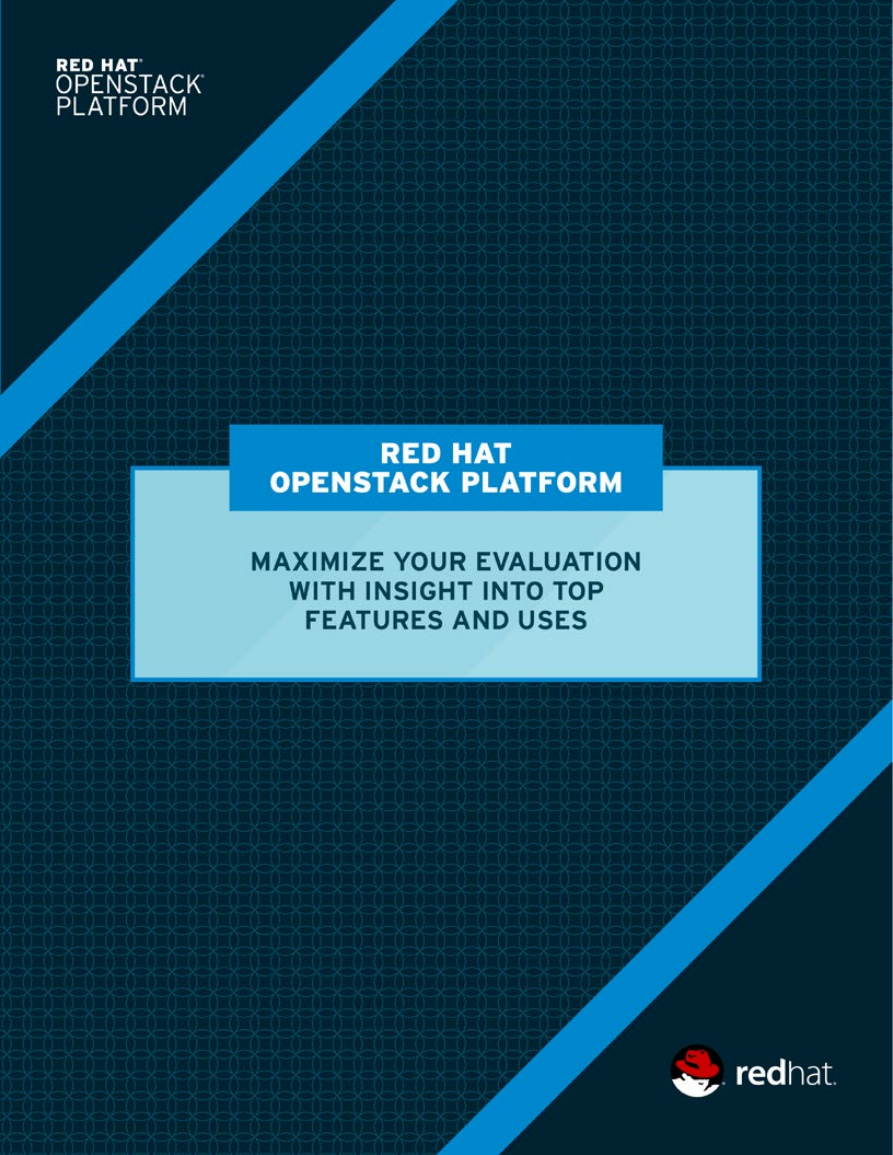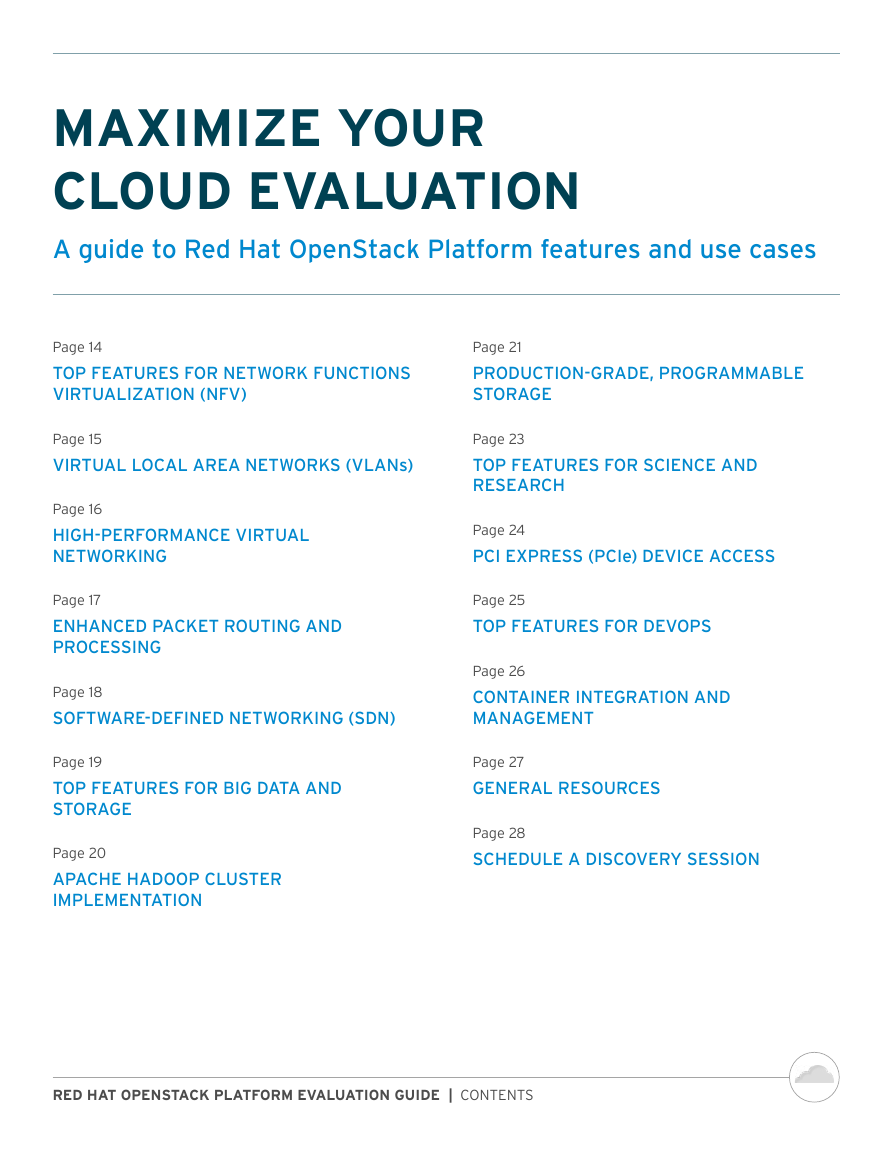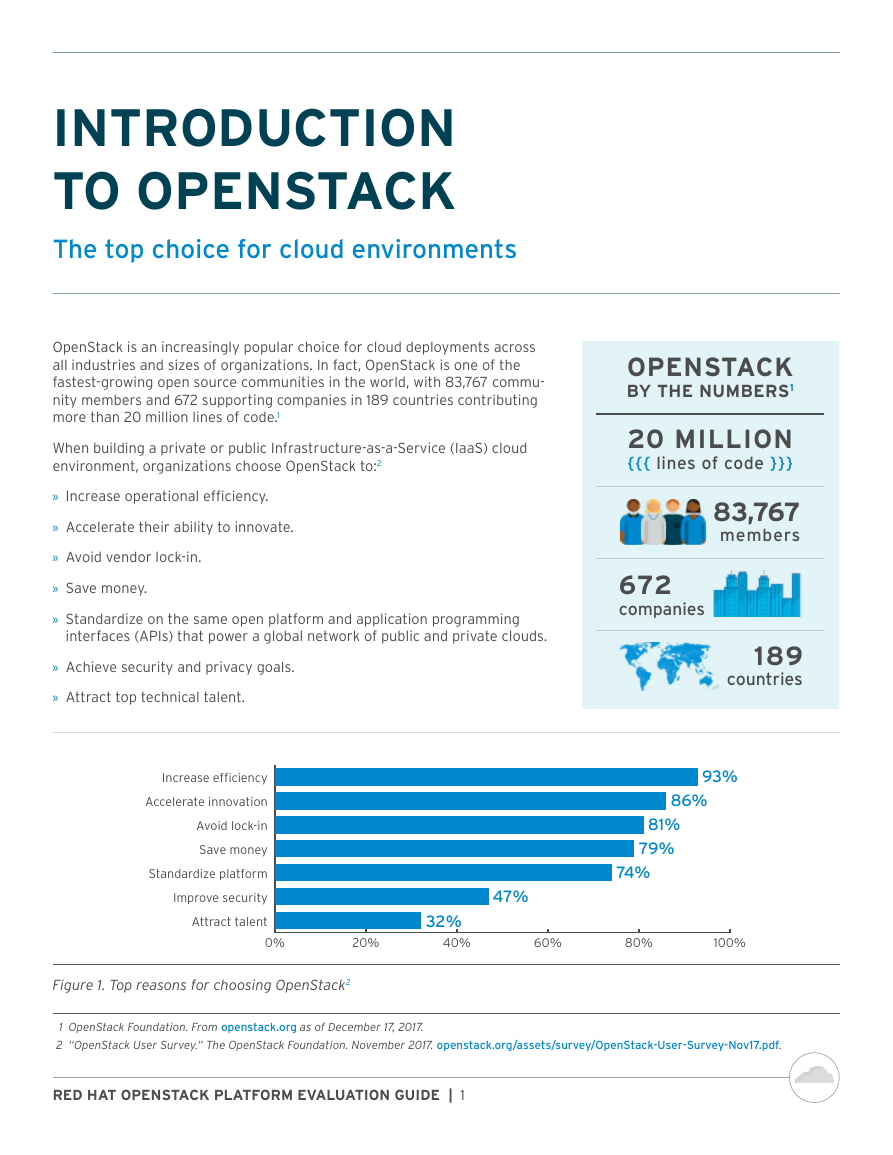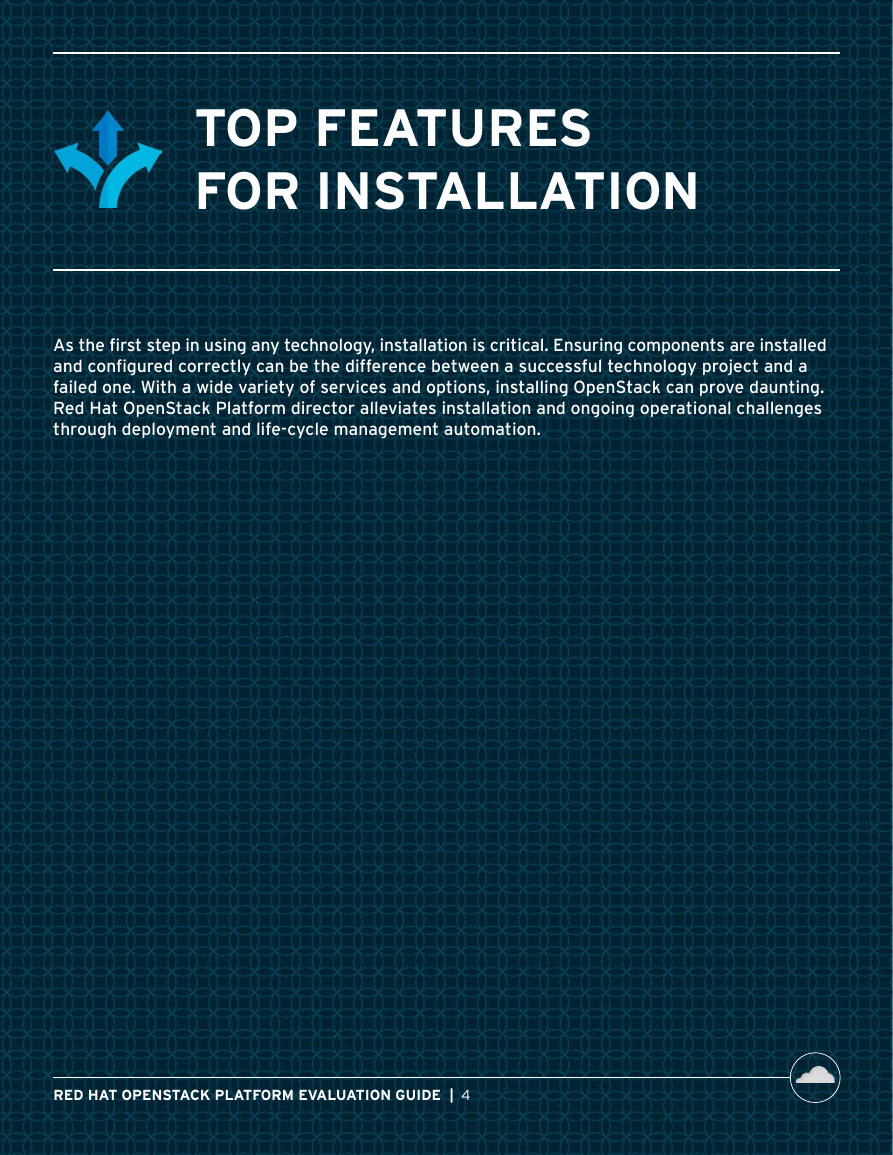�
MAXIMIZE YOUR
CLOUD EVALUATION
A guide to Red Hat OpenStack Platform features and use cases
This e-book provides an overview of select features, functionality, and use cases for Red Hat® OpenStack® Platform,
answering what?, why?, and how? for each topic. Each section is independent, so you can use the table of contents
to skip to sections that most interest you. Clicking on the cloud icon in the lower right corner of each page will return
you to this table of contents.
Links to key documents and websites are included in each section, as well as in the general listing at the end of
this e-book.
To get started:
» Download the Red Hat OpenStack Platform evaluation at: access.redhat.com/products/red-hat-openstack-platform/
evaluation.
» Review in-depth Red Hat OpenStack Platform product guides at: access.redhat.com/documentation/en-us/
red_hat_openstack_platform.
Page 1
INTRODUCTION TO OPENSTACK
Page 2
WELCOME TO THE CLOUD
Page 3
RED HAT OPENSTACK PLATFORM SERVICES
AND RELATIONSHIPS
Page 4
TOP FEATURES FOR INSTALLATION
Page 5
INTEGRATED DEPLOYMENT TOOLING
Page 7
TOP FEATURES FOR DAY-TO-DAY
OPERATIONS
Page 8
AUTOMATED UPDATE AND UPGRADE
PROCESSES
Page 9
INSTANCE LIVE MIGRATION
Page 10
UNIFIED LIFE-CYCLE MANAGEMENT
Page 13
COMPOSABLE ROLES AND SERVICES
RED HAT OPENSTACK PLATFORM EVALUATION GUIDE | CONTENTS
MAXIMIZE YOUR
CLOUD EVALUATION
A guide to Red Hat OpenStack Platform features and use cases
Page 14
TOP FEATURES FOR NETWORK FUNCTIONS
VIRTUALIZATION (NFV)
Page 21
PRODUCTION-GRADE, PROGRAMMABLE
STORAGE
Page 15
VIRTUAL LOCAL AREA NETWORKS (VLANs)
Page 16
HIGH-PERFORMANCE VIRTUAL
NETWORKING
Page 17
ENHANCED PACKET ROUTING AND
PROCESSING
Page 18
SOFTWARE-DEFINED NETWORKING (SDN)
Page 19
TOP FEATURES FOR BIG DATA AND
STORAGE
Page 20
APACHE HADOOP CLUSTER
IMPLEMENTATION
Page 23
TOP FEATURES FOR SCIENCE AND
RESEARCH
Page 24
PCI EXPRESS (PCIe) DEVICE ACCESS
Page 25
TOP FEATURES FOR DEVOPS
Page 26
CONTAINER INTEGRATION AND
MANAGEMENT
Page 27
GENERAL RESOURCES
Page 28
SCHEDULE A DISCOVERY SESSION
RED HAT OPENSTACK PLATFORM EVALUATION GUIDE | CONTENTS
�
INTRODUCTION
TO OPENSTACK
The top choice for cloud environments
OpenStack is an increasingly popular choice for cloud deployments across
all industries and sizes of organizations. In fact, OpenStack is one of the
fastest-growing open source communities in the world, with 83,767 commu-
nity members and 672 supporting companies in 189 countries contributing
more than 20 million lines of code.1
When building a private or public Infrastructure-as-a-Service (IaaS) cloud
environment, organizations choose OpenStack to:2
» Increase operational efficiency.
» Accelerate their ability to innovate.
» Avoid vendor lock-in.
» Save money.
» Standardize on the same open platform and application programming
interfaces (APIs) that power a global network of public and private clouds.
» Achieve security and privacy goals.
» Attract top technical talent.
TOP REASONS FOR CHOOSING OPENSTACK
Increase efficiency
Accelerate innovation
Avoid lock-in
Save money
Standardize platform
Improve security
Attract talent
0%
20%
Figure 1. Top reasons for choosing OpenStack2
OPENSTACK
BY THE NUMBERS1
20 MILLION
{{{ lines of code }}}
83,767
members
672
companies
189
countries
93%
86%
81%
79%
74%
47%
32%
40%
60%
80%
100%
1 OpenStack Foundation. From openstack.org as of December 17, 2017.
2 “OpenStack User Survey.” The OpenStack Foundation. November 2017. openstack.org/assets/survey/OpenStack-User-Survey-Nov17.pdf.
RED HAT OPENSTACK PLATFORM EVALUATION GUIDE | 1
�
WELCOME TO THE CLOUD
The power and stability of Red Hat OpenStack Platform
KEY FEATURES
» Co-engineered
performance
» Built-in security
» Unified cloud management
» Scale-out services,
including compute,
network, and storage
» Freedom from vendor
dependency
» Production-friendly life-
cycle and support options
As business competition and disruption increase across industries, IT
organizations are challenged to respond faster to new, growing, and
fast-changing customer demands. An OpenStack cloud environment can
provide agility and speed, but not all OpenStack distributions can meet
the additional demands of production-grade deployment, performance,
scalability, and security. Red Hat OpenStack Platform can.
Red Hat OpenStack Platform combines the power of Red Hat Enterprise
Linux® with OpenStack technology developed by Red Hat to deliver a
foundation for building private or public IaaS cloud environments. It offers
a highly scalable, fault-tolerant platform for running cloud-enabled work-
loads. Red Hat OpenStack Platform also lets you dynamically expand capacity
across cloud environments to meet demand peaks without downtime or
complex processes.
OpenStack depends on Linux as the operating environment for its services,
to access hardware resources, and for third-party integration with existing
or new systems. OpenStack also depends on Linux for system-wide perfor-
mance, scalability, and security and as an operating system for the guest
applications running in these virtual environments. This is why Red Hat —
recognizing the critical interdependencies between the two — co-engineered
Red Hat OpenStack Platform and Red Hat Enterprise Linux together with
closely aligned product engineering teams. Paired with Red Hat CloudForms’
open, hybrid management for workloads and infrastructure, as well as
Red Hat Ceph Storage’s highly redundant, software-defined storage, Red Hat
OpenStack Platform is an integrated, optimized, and managed foundation for
production-ready cloud environments.
Red Hat OpenStack Platform is also integrated with other products in
Red Hat’s software stack. Red Hat Ansible® Automation — simple, flexible IT
automation technology — works with Red Hat OpenStack Platform director to
simplify deployment, upgrades, and overall management. Red Hat OpenStack
Platform also makes an ideal foundation for Platform-as-a-Service (PaaS)
deployment with Red Hat OpenShift Container Platform — a platform for
building, deploying, and managing container-based applications consistently
across hybrid cloud and multicloud infrastructures.
RED HAT OPENSTACK PLATFORM EVALUATION GUIDE | 2
�
OPENSTACK SERVICES
AND RELATIONSHIPS
A modular, interoperable architecture for flexibility
Red Hat OpenStack Platform features a modular architecture based on a variety of interoperable services for compute,
networking, storage, management, orchestration, and more. These services can be used in any combination to align your
cloud infrastructure with the needs of your organization.
MONITORING
DATA
PROCESSING
ORCHESTRATION
SHARED SERVICES
DEPLOYMENT
AND
MANAGEMENT
IDENTITY
DIRECTOR
CEILOMETER
SAHARA
HEAT
KEYSTONE
COMPUTE
STORAGE
BLOCK STORAGE
IMAGE STORAGE
OBJECT STORAGE
NETWORKING
BARE-METAL
PROVISIONING
DASHBOARD
IaaS+
IaaS
NOVA
CINDER
GLANCE
SWIFT
NEUTRON
IRONIC
HORIZON
TRIPLEO
Modular architecture
High scalability
Core set of services
Figure 2. Red Hat OpenStack Platform modular architecture with interoperable services
RED HAT OPENSTACK PLATFORM EVALUATION GUIDE | 3
�
TOP FEATURES
FOR INSTALLATION
As the first step in using any technology, installation is critical. Ensuring components are installed
and configured correctly can be the difference between a successful technology project and a
failed one. With a wide variety of services and options, installing OpenStack can prove daunting.
Red Hat OpenStack Platform director alleviates installation and ongoing operational challenges
through deployment and life-cycle management automation.
RED HAT OPENSTACK PLATFORM EVALUATION GUIDE | 4
�
INTEGRATED
DEPLOYMENT TOOLING
Red Hat OpenStack Platform director
OpenStack cloud deployments are complex — there is no standard cloud configuration that fits all use cases. Differing
requirements, expectations, hardware, networking, storage, and datacenter services make it impossible to define
a single, standard deployment. In addition, OpenStack deployments themselves are complicated. According to the
OpenStack Foundation, the average OpenStack deployment deploys 11 OpenStack services.3
Director is the integrated deployment and life-cycle management tool included with Red Hat OpenStack Platform.
Integration with Red Hat’s management and automation tools allows you to use an infrastructure-as-code approach
to cloud management. Use director with Red Hat Ansible Automation to automate your cloud infrastructure, Red Hat
Satellite to manage subscriptions and content, and Red Hat CloudForms to perform advanced Day 2 operations.
Additionally, based on the upstream community’s TripleO project, director uses OpenStack services to install and
deploy your Red Hat OpenStack Platform environment. As a result, installation and management are aligned with
and benefit from improvements to the overall OpenStack platform.
OVERCLOUD (Deployed cloud)
CONTROLLER
NODES
COMPUTE
NODES
STORAGE
NODES
Deploy, configure,
and manage nodes
UNDERCLOUD (Director)
Figure 3. Red Hat OpenStack Platform director installs, configures, and manages OpenStack nodes
3 “OpenStack User Survey.” The OpenStack Foundation. November 2017. openstack.org/assets/survey/OpenStack-User-Survey-Nov17.pdf.
RED HAT OPENSTACK PLATFORM EVALUATION GUIDE | 5
�
















 2023年江西萍乡中考道德与法治真题及答案.doc
2023年江西萍乡中考道德与法治真题及答案.doc 2012年重庆南川中考生物真题及答案.doc
2012年重庆南川中考生物真题及答案.doc 2013年江西师范大学地理学综合及文艺理论基础考研真题.doc
2013年江西师范大学地理学综合及文艺理论基础考研真题.doc 2020年四川甘孜小升初语文真题及答案I卷.doc
2020年四川甘孜小升初语文真题及答案I卷.doc 2020年注册岩土工程师专业基础考试真题及答案.doc
2020年注册岩土工程师专业基础考试真题及答案.doc 2023-2024学年福建省厦门市九年级上学期数学月考试题及答案.doc
2023-2024学年福建省厦门市九年级上学期数学月考试题及答案.doc 2021-2022学年辽宁省沈阳市大东区九年级上学期语文期末试题及答案.doc
2021-2022学年辽宁省沈阳市大东区九年级上学期语文期末试题及答案.doc 2022-2023学年北京东城区初三第一学期物理期末试卷及答案.doc
2022-2023学年北京东城区初三第一学期物理期末试卷及答案.doc 2018上半年江西教师资格初中地理学科知识与教学能力真题及答案.doc
2018上半年江西教师资格初中地理学科知识与教学能力真题及答案.doc 2012年河北国家公务员申论考试真题及答案-省级.doc
2012年河北国家公务员申论考试真题及答案-省级.doc 2020-2021学年江苏省扬州市江都区邵樊片九年级上学期数学第一次质量检测试题及答案.doc
2020-2021学年江苏省扬州市江都区邵樊片九年级上学期数学第一次质量检测试题及答案.doc 2022下半年黑龙江教师资格证中学综合素质真题及答案.doc
2022下半年黑龙江教师资格证中学综合素质真题及答案.doc